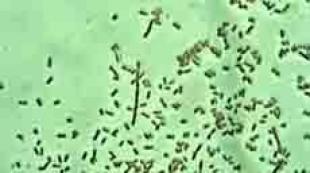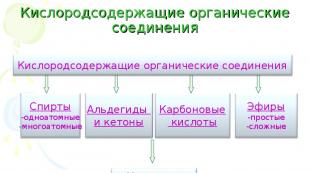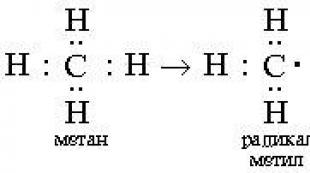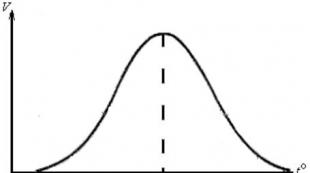Physiology of sensory systems. Sensory receptors. Nerve fibers, neuromuscular synapse The role of receptors in the formation of reflex arcs
Sensory receptors are specialized (often nerve) cells responsible for converting and transmitting information. Like normal nerve cells, they have dendrites and one or more axons. Receptors are specialized in accordance with the energy of the environment.
to which they react. For example, photoreceptors contain pigments that change chemically when exposed to light, and when stimulated, an electrical potential occurs. IN mechanoreceptors electrochemical changes occur due to deformation of the cell membrane. Energy conversion usually takes place in the cell body, and for all receptors it is characteristic that the energy of the environment is converted into a gradual electrical potential called generator potential, which is usually proportional to the intensity of receptor stimulation. When the generator potential reaches a certain threshold level, it triggers an action potential that runs along
axon of the receptor cell. This is the transmission part of the sensory process, and the information is usually encoded so that the stronger the stimulus, the higher the frequency of action potentials. In the absence of stimulation, the generator potential gradually decreases to resting levels. When it falls below the threshold, action potentials stop being generated. When stimulation is resumed, there may be a short delay (latency period) while the generator potential rises from resting to threshold. When stimulated intermittently, it rises and falls rhythmically, generating bursts of action potentials. However, if the frequency of intermittent stimulation is high enough, the generator potential may not have time to decrease between stimuli, and then the generation of action potentials will become continuous. This explains why, at a very high frequency of intermittent stimulation, we are unable to distinguish it from continuous stimulation. This phenomenon of flicker fusion is inherent in all senses, which is most obvious in the case of vision. The fact that rapidly flickering light produces the same visual sensation as constant light makes television and cinema possible.
Action potentials, which convey sensory information, are no different from any other nerve impulses. Their magnitude is determined by the size of the axon, and their frequency is determined by the strength of stimulation. Each type of receptor sends impulses directly or indirectly to a specific part of the brain. The sensations experienced do not depend on the type of receptor or the messages it sends, but on the part
brain that receives these messages. The localization of sensation also depends on the brain. So, for example, in case of pain, nerve fibers from the hand send signals to one part of the brain, from the forearm to another, etc. The “pain” experienced by the brain is localized to the part of the body from which the message came. This phenomenon is illustrated by reports from people who have undergone limb amputation. who complain of pain that seems to come from a distant (phantom) limb. Stimulation of the cut nerve endings sends impulses to the parts of the brain that were connected to the amputated limb. The brain interprets incoming signals as coming from the lost limb, and the resulting sensations depend on which nerve is irritated. This phantom limb may also produce sensations of heat, cold, or touch.
Muscles and glands
The nervous system controls the behavior and, to some extent, the internal environment of the animal (see Chapter 15). This control is carried out by orders given to the muscles and glands.
Muscle cells contain complex protein molecules that can contract and relax. Nerve endings are connected to muscles through synapses similar to those by which neurons are connected to each other. Arriving at the neuromuscular junction, nerve impulses produce electrical potentials that cause the muscle to contract. Its relaxation occurs in the absence of stimulation. When contracting, the muscle shortens if this is not prevented by holding both its ends. When relaxed, a muscle can lengthen, but only if it is stretched by other muscles or some external force. Muscles are usually arranged in antagonistic, opposing groups. In some invertebrates, such as annelids, muscle contraction may be inhibited by hydrostatic
logical pressure that increases when the muscular part of the body cavity is compressed. This pressure causes the muscles to lengthen when they relax. In other invertebrates, such as arthropods, muscles are located within a rigid exoskeleton, which forms a non-
the necessary system of levers for antagonistic muscle groups (Fig. 11.5). In vertebrates, such a system is the internal skeleton, and the muscles are located so that they pull its parts in opposite directions (Fig. 11.6). One muscle group relaxes when another contracts.
Some glands are under nervous control. In vertebrates, these include, for example, the salivary glands, the adrenal medulla, which produces adrenaline, and the posterior pituitary gland, which produces several important hormones. The secretions of these glands can influence behavior indirectly by influencing the internal state of the animal, as will be shown at the end of this chapter.
Depending on their structural organization and function, sensory receptors can be primary or secondary sensory. Primary sensory receptors- These are the nerve endings of the processes of sensory neurons. They are present in the skin and mucous membranes, skeletal muscles, tendons and periosteum, as well as barrier structures of the internal environment - the walls of blood and lymphatic vessels, the interstitial space, in the membranes of the brain and spinal cord, and the cerebrospinal fluid system. Based on the nature of the perceived stimuli, primary sensory receptors are divided into:
mechanoreceptors (perception of stretching or compression, linear or radial shift of tissue);
chemoreceptors (perception of chemical stimuli);
thermoreceptors (temperature perception);
nociceptors (pain perception).
Secondary sensory receptors- these are receptor cells specialized for the perception of certain stimuli, usually of an epithelial nature, which are part of the sense organs - vision, hearing, taste, balance. After perceiving the stimulus, these receptor cells transmit information to the endings of the afferent conductors of sensory neurons. Thus, the afferent neurons of the nervous system receive information about the stimulus that has already been processed in receptor cells (which determined the name of these receptors).
All types of receptors, depending on the source of perceived irritation, are divided into exteroceptors(perceiving stimuli from the external environment) and interoceptors(intended for irritants of the internal environment). Among the interoceptors, proprioceptors are distinguished, i.e. own receptors of the musculoskeletal system, angioreceptors located in the walls of blood vessels, and tissue receptors localized in the interstitial space and cellular microenvironment. A special place among proprioceptors is occupied by muscle spindles, which are formations that respond to muscle stretching and are capable of changing their sensitivity under the influence of impulses coming to them from the central nervous system. These receptors are involved in the regulation of muscle tone
A common functional property of all types of sensory receptors is the ability to convert one type of energy into another: mechanical, thermal, light, sound, etc., the energy of stimuli into electrical energy of biopotentials, i.e. nerve impulses.
Since receptors are specialized for the perception of a certain type of stimulus, their sensitivity to such stimuli is greatest. The minimum strength of the stimulus that can excite the receptor is called the absolute threshold of stimulation. In this regard, stimuli for which the receptor has the highest sensitivity, i.e. minimum threshold value are called adequate. At the same time, some receptors can also respond to stimuli that do not correspond to their specialization; the threshold for such stimuli, called inadequate, turns out to be very high and a significant strength of the stimulus is required to excite the receptor.
If the primary sensory receptors are formed by branches of the process of one sensory neuron, they form the receptive field of the sensory neuron. Typically, receptors form clusters of varying densities in tissues. In cases where these accumulations give rise to a specific reflex, they are called receptive reflex fields. If a cluster contains receptors of different types of stimuli that give rise to different reflexes, they are called reflexogenic zones. An example is the vascular reflexogenic zones, where mechano- and chemoreceptors are located, the irritation of which causes various reflex reactions of the cardiovascular, respiratory and other body systems.
Analyzers (sensory systems) are designed to provide the body with information about changes occurring in the habitat and in the internal environment of the body.
Analyzer - a set of peripheral, conductive and central nervous formations that perceive and analyze signals about changes in the external and internal environments of the body.
Sense organ - peripheral formation that perceives and partially analyzes changes in existing environmental factors.
Receptors (sensory) - groups of specialized cells localized in the sensory organ or internal environment of the body, capable of perceiving, transforming and transmitting information about operating environmental factors to the central nervous system.
Sensory system – a system of peripheral (receptor, sensory organ), communicative (conducting department) and central nervous formations that ensure the body receives information about events in the internal and external environment and controls the activity of perceiving structures.
The afferent link of sensory systems (receptors and pathways) always prevails over the efferent one. In any mixed nerve of the body, the number of sensory fibers exceeds the number of motor fibers, for example, in the vagus nerve the portion of afferent fibers is 92%.
Based on the direction of functional responsibility, analyzers are divided into external and internal.
1. External analyzers perceive and analyze changes in the external environment. These include visual, auditory, olfactory, gustatory, tactile and temperature analyzers, the activity of which is perceived subjectively in the form of sensations.
2. Internal (visceral) analyzers perceive and analyze changes in the internal environment of the body. Fluctuations in indicators of the internal environment within the physiological range are usually not perceived by a person in the form of sensations (blood pH, CO 2 content in it, blood pressure, etc.).
Analyzer departments. According to the idea put forward by I.P. Pavlov, all analyzers have three functional and anatomical sections.
Peripheral section of the analyzer represented by receptor cells. Receptors are characterized by specificity, modality, or the ability to perceive a certain type of energy of an active adequate stimulus (Müller's law of specific energy).
Conductor section of the analyzer includes afferent (peripheral) and intermediate neurons (including their processes) of the stem and subcortical structures of the central nervous system. Conducting pathways provide undecremental transmission of signals to the cerebral cortex with intermediate analysis and compaction of information during the transmission of nerve impulses at synapses.
The central, or cortical, section of the analyzer, according to I.P. Pavlov, it consists of two areas: the central (“core”, primary), represented by specific neurons that process incoming impulses from the conductive part of the analyzer, and the peripheral, secondary, where populations of neurons receive afferent inputs from the peripheral sections of various analyzers.
The cortical projections of the analyzers are also called “sensory areas”.
Analyzers are characterized by high sensitivity to the action of a modally specific stimulus, determined not only by the properties of the receptors, but also by the functioning of the cortical unit.
Some laws for the functioning of analyzers have been established.
Weber's law
Discrimination threshold PR=ΔI/I=const
describes the dependence of the threshold for the occurrence of a subjective sensation of an increase in stimulus intensity on the strength of the stimulus.
In logarithmic form, this dependence is expressed by Fechner’s law
Intensity of sensation Estr.=Кlg (ΔI/I)
It is curious that the patterns described by the Weber-Fechner law were known to people back in the Ancient era. Astronomers, in particular Hipparchus, when they created a scale of stellar magnitudes depending on their brightness, used visual observations, i.e. properties of your visual analyzer. The modern classification of stars according to their luminosity confirms that, in fact, Hipparchus was the first to establish the logarithmic nature of the dependence of the threshold for distinguishing sensations during the operation of the visual analyzer, without realizing it.
When analyzing the activity of the afferent link of many analyzers, approximately the same pattern is revealed. It is more convenient to describe it with the Stevens power function
For values n=1, the Stevens function is an ordinary directly proportional function, but for n<1 (как это бывает в большинстве внешних анализаторов) кривая, описывающая эту функциональную закономерность на графике, круто уходит вверх при небольших приростах аргумента. Это означает, что происходит уплотнение информации (фактически, математическое логарифмирование) на уровне рецепторов для передачи ее в сжатом виде в ЦНС.
The main functions of the sensory organs and afferent parts of any analyzers are determined by the properties of sensory receptors.
In sensory physiology, receptors are divided into external (exteroceptors) and internal (interoceptors).
Receptors are classified by modality
Mechanoreceptors (hair cells - phonoreceptors, Pacinian corpuscles, baroreceptors, stretch receptors, muscle spindles, etc.)
Thermoreceptors (localized in internal organs and skin)
Chemoreceptors (glucoreceptors, osmoreceptors, receptors of the olfactory and gustatory sensory system)
Photoreceptors (rods and cones, infrared detector in snakes)
Electroreceptors (in some fish and amphibians)
Pain receptors or nociceptors (often multimodal receptors and tissue ischemic receptors).
The most important property of receptors is their high selective sensitivity to the action of adequate stimuli, which is ensured by the structural features of their localization in tissues and the presence of satellite cells. Based on the presence of accompanying receptor cells, all receptors are divided into two groups.
1.Primary receptors, or primary sensory receptors. Detection of the stimulus occurs directly at the end of the sensory neuron, localized in the periphery (the body of the nerve cell may be far from the place of action of the stimulus, in some sensory ganglion). Receptor potential And generator potential arise in one nerve cell. Example - Mechanoreceptors, proprioceptors, nociceptors, chemoreceptors.
2.Secondary receptors, secondary sensory receptors. Between the end of the sensory neuron and the site of perception of the stimulus there is an auxiliary receptive cell. Receptor potential arises in the receptive satellite cell, it synaptically activates the afferent neuron, in which it is generated generator potential. An example is photoreceptors, phonoreceptors of the inner ear.
Mechanisms of receptor act .
The action of the stimulus does not lead to the transfer of energy to the receptor; the energy in the cell receiving the stimulus is already stored by the work of K + –Na + ATPase. Only a stimulus in the form of a photon, environmental vibrations, or a change in the concentration of a substance initiates signal transduction.
Receptive cells are characterized by the existence of a resting potential. The plasmalemma of the cell separates areas with opposite charges. A negative charge inside and a positive charge outside, in the interstitium, ensures that the receptor is ready to generate a signal. Most often, the signal that the receptor cell generates is the receptor potential, this is a gradual, electrotonically propagating potential, in the form of depolarization or hyperpolarization. The potential is intended to initiate the process of the chemical link of message transmission at the synapse formed by the receptor cell on the afferent neuron. Cations act as charge carriers in cells. The cable properties of the membranes are used.
For primary senses receptors, the sequence of events is described by the following scheme.
3. Propagation of the receptor potential by electrotonic method to the most excitable area of the peripheral process of the neuron
4.Generation of action potential. RP=GP
For secondary receptor
1. Specific interaction of the stimulus with the receptor membrane at the molecular level
2. The emergence of a receptor potential at the site of localization of sensitive ion channels
3. Propagation of the receptor potential electrotonic way to the synapse with the peripheral process of the neuron
4. Release of transmitter at the synapse
5. Generation of EPSP (excitatory postsynaptic potential) in the membrane of the afferent neuron. EPSP=GP
6.Electrotonic propagation of the GP to the most excitable area of the afferent neuron
7. Generation of PD and its transmission to the central nervous system.
The main function of the receptors (and the afferent link of any analyzer) is the conversion of analog signals from the external or internal environment (light, sound, heat, pressure) into a frequency (digital) code, which can be transmitted, if possible, in a compressed form, but without distortion of the information component. Therefore, the converted signal looks like a set of action potentials (impulses), following with a certain frequency. But not only frequency is important. Useful information of the code can be the number of pulses, the inter-pulse interval, the presence of pulses or their absence. In this case, often the interpulse intervals even in one afferent sending, or a series of impulses, can be equal or different. The logarithmic nature of the dependence of the response of the afferent link to the action of the stimulus and the integrating role of the sensory neuron makes it possible to minimize the time code and transmit information for which the sensory system is responsible to the central nervous system without distortion.
Both the strength of irritation and its quality are coded. The location of the stimulus is also coded. There are different hypotheses about the organization of processes for analyzing information in the brain coming from afferent systems.
Hypothesis labeled line, or the theory of specificity, postulates the existence of special anatomically determined chains of neurons, communication channels, specific for each current stimulus.
Supporters pattern hypotheses, or intensity, it is believed that the transmission of information about the quality of the stimulus is encoded by the spatiotemporal pattern (pattern) of excitations of many populations of receptors, and the final analysis occurs only at the level of the cerebral cortex.
1.2.1. Structural and functional characteristics of sensory receptors
Properties of sensory receptors. The excitability of the receptors is very high, it exceeds the sensitivity of the latest technical devices that record the corresponding signals. In particular, 1-2 quanta of light are enough to excite the photoreceptor of the retina, and one molecule of an odorous substance is enough for the olfactory receptor. However, the excitability of visceroreceptors is lower than that of exteroceptors. Pain receptors, adapted to respond to the action of damaging stimuli, have low excitability.
Receptor adaptation - this is a decrease in their excitability during prolonged exposure to a stimulus, expressed in a decrease in the amplitude of the RP and, as a consequence, the frequency of impulses in the afferent nerve fiber. At the initial stage of the action of stimuli, their auxiliary structures can play an important role in the adaptation of receptors. For example, the rapid adaptation of vibration receptors (Pacinian corpuscles) is due to the fact that their capsule allows only rapidly changing parameters of the stimulus to pass through to the nerve ending and “filters out” its static components. It should be noted that the term “dark adaptation” of photoreceptors means an increase in their excitability. One of the mechanisms of receptor adaptation is the accumulation of Ca 2+ in it upon excitation, which activates Ca 2+ -dependent potassium channels; the release of K+ from the cell through these channels prevents depolarization of its membrane and, consequently, the formation of RP. Biochemical reactions that block the formation of RP have been discovered. The significance of receptor adaptation is that it protects the body from an excessive flow of impulses, and sometimes from unpleasant sensations.
Spontaneous activity some receptors (phono-, vestibulo-, thermo-, chemo- and proprioceptors) without the action of an irritant on them, which is associated with the permeability of the cell membrane to ions, periodically leading to a decrease in PP to CP and the generation of AP in the nerve fiber. The excitability of such receptors is higher than that of receptors without background activity; even a weak stimulus can significantly increase the firing rate of a neuron. The background activity of receptors under conditions of physiological rest is involved in maintaining the tone of the central nervous system and the wakeful state of the body.
Function of sensory receptors(lat. sensus-feeling, receptum-accept) is the perception of stimuli - changes in the external and internal environment of the body. This is accomplished by converting the energy of stimulation into the RP, which ensures the emergence of nerve impulses.
Each type of receptor in the process of evolution is adapted to the perception of one or several types of stimuli. Such stimuli are called adequate. Receptors to them have the greatest sensitivity (for example, the receptors of the retina of the eye are excited by the action of 1-2 quanta of light energy). To others - inadequate stimuli- receptors are insensitive. Inappropriate stimuli can also excite sensory receptors, but the energy of these stimuli must be millions and billions of times greater than the energy of adequate ones. Sensory receptors are the first link in the reflex pathway and the peripheral part of the sensory systems.
Classification of sensory receptors carried out according to several criteria (Fig. 12).
Rice. 12. Classification of receptors into primary and secondary. Secondary receptors have a receptor cell to which the afferent endings of the sensory neuron approach (Agajanyan, 2007).
According to structural and functional organization differentiate primary And secondary receptors.
Primary receptors represent the sensory endings of the dendrite of the afferent neuron. These include olfactory, tactile, temperature, pain receptors and proprioceptors. The body of the neuron is located in the spinal ganglia or in the ganglia of the cranial nerves.
Secondary receptors have a special cell synaptically connected to the end of the dendrite of the sensory neuron. Secondary receptors include taste, photo (visual), phono (auditory) and vestibuloreceptors.
By speed of adaptation differentiate rapidly adapting (phasic), slowly adapting (tonic) and mixed (phasic-tonic) receptors, adapting at an average speed. An example of rapidly adapting receptors are the vibration (Pacini corpuscles) and touch (Meissner corpuscles) receptors of the skin. Slowly adapting receptors include proprioceptors, some pain receptors, and mechanoreceptors of the lungs. The photoreceptors of the retina and thermoreceptors of the skin adapt at an average speed.
Depending on the type of perceived stimulus allocate four types receptors, namely: chemoreceptors- taste and olfactory receptors, part of the vascular and tissue receptors (responsive to changes in the chemical composition of blood, lymph, intercellular fluid) - are present in the hypothalamus (for example, in the food center) and the medulla oblongata (respiratory center); mechanoreceptors- located in the skin and mucous membranes, musculoskeletal system, blood vessels, internal organs, auditory, vestibular and tactile sensory systems; thermoreceptors(they are divided into heat and cold) - are found in the skin, blood vessels, internal organs, various parts of the central nervous system (hypothalamus, mid, medulla and spinal cord); photoreceptors- located in the retina of the eye, they perceive light (electromagnetic) energy.
Depending on ability perceive one or more types of stimuli allocate monosensory(have maximum sensitivity to one type of stimulus, for example, retinal receptors) and polysensory(perceive several adequate stimuli, for example mechanical and temperature or mechanical, chemical and pain) receptors. An example is irritant receptors of the lungs, pain receptors.
By location in the body receptors are divided into extero- And interoreceptors. TO interoreceptors include receptors of internal organs (visceroreceptors), blood vessels and the central nervous system. A variety of interoreceptors are receptors of the musculoskeletal system (proprioceptors) and vestibular receptors. TO exteroceptors These include receptors of the skin, visible mucous membranes (for example, the oral mucosa) and sensory organs: visual, auditory, taste, thermoreceptors, olfactory.
Feels like receptors divided into visual, auditory, gustatory, olfactory thermoreceptors, tactile, pain(nociceptors) are free nerve endings that are found in teeth, skin, muscles, blood vessels, and internal organs. They are excited by the action of mechanical, thermal and chemical (histamine, bradykinin, K +, H +, etc.) stimuli.
Mechanism of receptor excitation(Fig. 13).

Rice. 13. The mechanism of occurrence and transmission of a signal from a receptor cell (Chesnokova, 2007)
When exposed to an adequate stimulus in primary receptor a receptor potential (RP) arises, which is a depolarization of the cell membrane, usually due to the movement of Na + ions into the cell. RP is a local potential, it is an irritant of the nerve ending (due to its electric field) and ensures the occurrence of AP in the pulpal fibers - in the first node of Ranvier, in the non-pulpal fibers - in the immediate vicinity of the receptor.
In secondary receptors When exposed to a stimulus, RP also first appears in the receptor cell due to the movement of Na + into the cell (taste buds) or K + (auditory and vestibular receptors).
Under the influence of the RP, a mediator is released into the synaptic cleft, which, acting on the postsynaptic membrane, ensures the formation of the generator potential of the GP (also local).
The latter is a stimulus (electric field) that ensures the occurrence of AP in the nerve ending, as well as in the endings with primary receptors.
The dependence of the AP frequency in the afferent nerve fiber on the RP value is shown in Fig. 14.

Rice. 14. Typical relationships between the amplitude of the RP and the frequency of APs arising in the efferent nerve fiber at suprathreshold levels of the RP (Guyton, 2008)
Concept of sensory receptors. The main component of the peripheral sensory systems is receptor. It is a highly specialized structure (for primary sensory receptors it is a modified dendrite of an afferent neuron, for secondary sensory receptors it is a sensory receptor cell), which is capable of perceiving the action of an adequate stimulus from the external or internal environment and ultimately transforming its energy into action potentials - the specific activity of the nervous system . It should be recalled here that the concept of “receptor” (from the Latin geserio, gesertum - to take, accept) in physiology is used in two meanings. Firstly, to designate specific proteins of the cell membrane or cytosol, which are intended for the detection of hormones, mediators and other biologically active substances. Such receptors are usually called membrane, cellular, or hormonal (for example, alpha-adrenergic receptors). Secondly, to designate receptors as components of the sensory system. These receptors are often called sensory receptors, or sensory receptor cells.
Classification of receptors. Depending on whether stimuli are perceived from the internal or external environment, all sensory receptors are divided into exteroceptors And interoreceptors. Exteroceptors perceive signals from the external environment. These include retinal photoreceptors, phonoreceptors of the organ of Corti, vestibuloreceptors of the semicircular canals and vestibular sacs, tactile, temperature and pain receptors of the skin and mucous membranes, taste buds of the tongue, olfactory receptors of the nose. Among interoreceptors, there are visceroreceptors, designed to detect changes in the internal environment, and propreceptors (receptors of muscles and joints, i.e., the musculoskeletal system). Visceroceptors are various chemo-, mechano-, thermo-, baroreceptors of internal organs and blood vessels, as well as nociceptors.
Based on the nature of contact with the environment, exteroceptors are divided into distant receiving information at a distance from the source of stimulation (visual, auditory and olfactory) and contact- excited by direct contact with a stimulus (gustatory, tactile).
Depending on the type of modality of the perceived stimulus, i.e. Based on the nature of the stimulus to which the receptors are optimally tuned, sensory receptors are divided into 6 main groups: mechanoreceptors, thermoreceptors, chemoreceptors, phonoreceptors, nociceptors and electroreceptors (the latter are found only in some fish and amphibians).
Mechanoreceptors are adapted to perceive the mechanical energy of an irritating stimulus. They are part of the somatic (tactile), musculoskeletal, auditory, vestibular and visceral sensory systems, as well as (in fish and amphibians) the lateral line sensory system. Thermoreceptors perceive temperature stimulation, i.e. the intensity of molecular movement, and are part of the temperature sensory system. They are represented by heat and cold receptors of the skin, internal organs and thermosensitive neurons of the hypothalamus. Chemoreceptors are sensitive to the action of various chemicals and are part of the gustatory, olfactory and visceral sensory systems. Photoreceptors sense light energy and form the basis of the visual sensory system. Pain (nociceptive) receptors perceive pain stimuli, including mechanonocyceptors - the action of excessive mechanical stimuli, chemonocyceptors - the action of specific pain mediators; they are the initial component of the nociceptive sensory system. Electroreceptors identified in the lateral line of a number of fish and amphibians are sensitive to the action of electromagnetic oscillations.
It should be emphasized that in the process of evolution those receptors and corresponding sensory systems were selected that provided each organism with a sufficient amount of information necessary for its normal existence and adaptation in the external environment. In this regard, we can quote a figurative phrase (A.D. Nozdrachev et al., 1991): “Electroreceptors that exist in fish have not been found in humans; there are no receptors that perceive direct infrared radiation, like a rattlesnake; the human eye does not perceive the polarization of light, like the eyes of some insects, his ear does not sense ultrasonic vibrations, like the hearing aid of bats and many nocturnal mammals.” But, in general, the sensory systems available to humans allow him to explore the Earth more successfully than other representatives of the animal world.
In addition to the two classifications presented, it is important to divide all sensory receptors depending on their structure and relationship with the afferent sensory neuron into two large classes - primary-sensing (primary) and secondary-sensing (secondary) receptors. This determines the selective sensitivity of the receptor to adequate stimuli (in secondary sensors it is much greater than in primary sensors), as well as the sequence of transformation of the energy of the external signal into the action potential of the neuron.
Primary sensory receptors include those receptors that are a modified, specialized ending of the dendrite of an afferent neuron. This means that the afferent neuron directly (i.e., primarily) interacts with an external stimulus. Primary sensory receptors include certain types of mechanoreceptors (free nerve endings of the skin and internal organs), cold and heat thermoreceptors, nociceptors, muscle spindles, tendon receptors, joint receptors, olfactory receptors.
Secondary receptors are cells of non-nervous origin specially adapted for the perception of an external signal, which, when excited in response to the action of an adequate stimulus, transmit a signal (usually with the release of a transmitter from the synapse) to the dendrite of the afferent neuron. Consequently, in this case, the neuron perceives the stimulus indirectly, indirectly (secondarily) due to the excitation of the sensory receptor cell (receptive cell). Secondary sensory receptors include many types of mechanoreceptors in the skin (for example, Pacinian corpuscles, Merkel discs, Meissner cells), photoreceptors, phonoreceptors, vestibuloreceptors, taste buds, and electroreceptors in fish and amphibians.
Adaptation of sensory receptors. Sensory receptors are capable of adaptation, which consists in the fact that with constant exposure to a stimulus on a sensory receptor, its excitation weakens, i.e. the magnitude of the receptor potential decreases, as well as the frequency of generation of action potentials by the afferent neuron. A similar phenomenon is observed during hormone receptor interaction. In this case, it is called desensitization and is associated with disturbances in downstream signal transmission. Adaptation of sensory receptors is even more complex. On the one hand, it depends on the processes that occur at the stage of interaction of the sensory stimulus with the “active center” of the sensory receptor (in essence, this is the phenomenon of desensitization). On the other hand, adaptation of receptors is associated with the flow of impulses coming to the sensory receptor via efferent fibers from overlying neurons of the brain (including neurons of the reticular formation), i.e. is an active process. To a certain extent, adaptation may be determined by the properties and state of the auxiliary structures of the peripheral sensory system. In general, adaptation manifests itself in a decrease in absolute and increase in differential sensitivity of the sensory system. The speed of adaptation for different recipes is different: the greatest for tactile receptors, and the smallest for vestibular and proprioceptors. Thanks to the high speed of adaptation of tactile receptors, we quickly stop feeling the glasses, watches or clothes we are wearing, and thanks to the low speed of adaptation of muscle receptors, we can make highly coordinated and clear movements.
The main stages of converting the energy of an external stimulus into a receptor potential (mechanisms of excitation of sensory receptors). With all the diversity of morphofunctional features of sensory receptors, the general scheme of this process can be represented in the form of some generalized diagram. IN primary receptors Conventionally, five main stages of sensory signal transduction can be distinguished: 1) interaction of the perceived stimulus with the “active” part of the sensory receptor; 2) change in ionic permeability of the membrane; 3) a decrease in the level of the membrane potential of the sensory receptor, i.e. generation of receptor potential, the level of which depends on the magnitude of the perceived stimulus; 4) generation of action potentials or an increase in the frequency of generation of spontaneous action potentials in the soma of the afferent neuron (axon hillock); 5) propagation of action potentials along the axon to the second afferent neuron of a given sensory system. In secondary senses in sensory cells, the first three stages follow the same pattern; then two more intermediate stages are added - 4a) release of mediator quanta (for example, acetylcholine) at the synapse of the receptor cell under the influence of the receptor potential; 5a) the response of the dendrite of an afferent neuron to the release of a transmitter by generating an excitatory postsynaptic potential, or generator potential. The remaining two stages (4 and 5) proceed in the same way as in primary sensory receptors. The only exception to this rule is the chain of events in the visual sensory system, in which, in response to the action of light, the photoreceptor cell increases its membrane potential, as a result of which the production of an inhibitory transmitter decreases in it, which ultimately leads to the excitation of the bipolar neuron, which in turn turn excites the ganglion cell.









